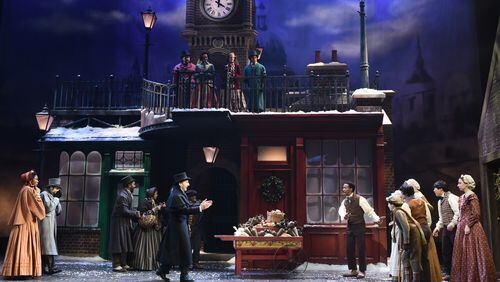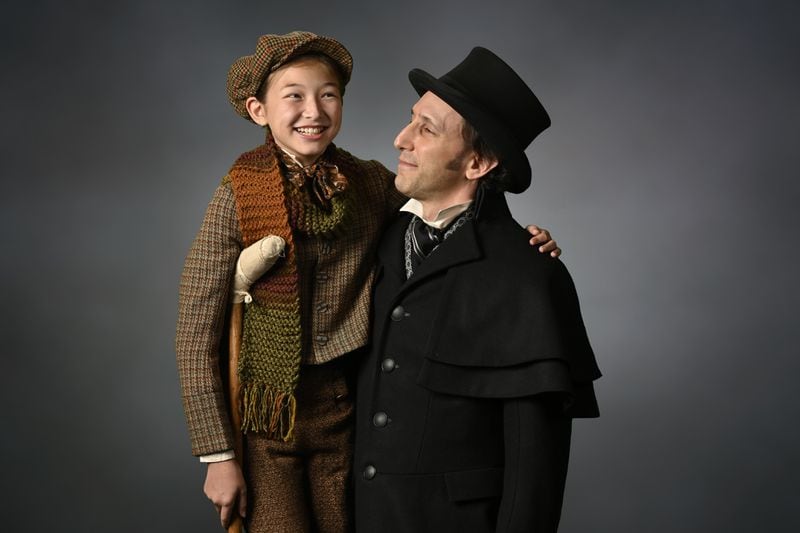There’s a meme going around the internet and perhaps you’ve seen it:
This holiday season, it’s important to remind people of the true meaning of Christmas: ghosts terrorizing rich people in the middle of the night until they agree to pay their employees more.
It’s time again for the Alliance Theatre’s “A Christmas Carol,” Charles Dickens’ heartwarming fable of extreme wealth inequality and Victorian meat puddings. It’s set, lovingly, in the era long before polio and tuberculosis vaccines, which might have saved the life of Tiny Tim, even without Scrooge’s intervention.
It’s a ghost story that triggers the happiest sentimentality — God bless us, every one! — although we never learn its lessons. We embrace “A Christmas Carol,” and yet society still privileges the “job creators” ahead of the clerks and maids. Scanning the audience, I didn’t spot any of the celebrity tycoons known for having a business model based on impoverishing their workers. But as these billionaires have shrewdly calculated, and as the Ghost of Marley cries out in repentance, “The poor are poor because we made them so!”
This element comes to the fore in the Alliance’s retelling. In David H. Bell’s adaptation, replacing his earlier one that enjoyed a two-decade run, the core of his new narrative revolves around the selfish harm done by a rich individual to a whole town of people, a whole lifetime of people.
It works, in part, because Leora Morris’ incisive stage direction helps shape distinct personalities within a large cast of characters. Most of the actors play multiple roles or sing as street carolers, thoroughly convincingly.
Credit: Shutterstock
Credit: Shutterstock
It works, too, since Andrew Benator’s Ebenezer Scrooge is awkward in manner, with a narrow, inexpressive face. Quite naturally, he seems the clinical, cerebral villain.
In an early scene, we see Mr. Watkins selling fruit from his cart with his young family, trying to make ends meet. (Watkins is played by Neal Ghant, who gives this small part real intensity.) Scrooge comes along, demanding loan repayment. They don’t have the money yet. As Mr. Watkins is arrested and thrown into debtor’s prison — whose interests are the police serving? — we see that Benator’s Scrooge is not, in fact, emotionally invested in cruelty. This feels very different from a typical Scrooge portrayal.
His treatment of Bob Cratchit (Christopher L. Morgan) is likewise transactional. Benator’s miser is more amoral than immoral. You believe his actions are a calculation, not cultural bigotry against people who don’t understand — or know how to play — the system that men like Scrooge created.
Scrooge’s wise and loyal nephew, Fred (Caleb Clark, dashing and earnest), offers the old man the most direct link to his humanity, and here again it’s rebuffed with a disinterested chill. (Clark also plays Ebenezer as a young man, and his brief and painful scenes with fiancée Belle, played beautifully by Maggie Birgel, are among the production’s most touching moments.)
As an evening of theater, all the pieces are in place. It looks expensive. The production has its own charms and delights, overstuffed like a Christmas goose, centered around a clever, four-sided set, designed by Todd Rosenthal. An imposing brick clock tower sits in the middle. The offices and living rooms and storefronts spin around on a turntable, with a cobbled street in front. Add a gentle snowfall and the heavy dresses and frock coats of 19th-century costumes (designed by Mariann Verheyen) and it’s a nostalgic treat for the eyes. Supernatural visitors, such as Marley’s face on the door knocker, or the Ghost of Christmas Future, make a sensational impression.
Wonderfully, the show is full of Christmas music. Members of the cast gather to sing familiar carols, backed by four musicians in the pit. Arrangements and interludes of original music are by noted Atlanta composer Kendall Simpson, who taps broad styles, from layered Philip Glass arpeggios to perky Mozartean minuets.
There are showstoppers, too. When Mr. Fezziwig (Ghant, again) throws a party, the guests start dancing and singing “Deck the Halls” with such controlled abandon, you wish your own social life were as merry and well organized. Later, when Scrooge and the Ghost of Christmas Present (Eugene H. Russell IV, sassy and charismatic) visit the Cratchit family, a one-house surplus of population, Tiny Tim (Chloe Gia Bremer) sings “Silent Night” with disarming poise and clarity.
Yet Bell’s new script comes with a few misreadings of Dickens. The character of Mrs. Dilber (Margaret Ivey), for example, is reassigned in this version from ransacking Scrooge’s house after he’s dead into Scrooge’s affectionate housekeeper. Say what? He’s interacting with someone generous and kind, daily, in his own home? Bob Cratchit is mistreated at work, sure, but his job is tabulating numbers. Ivey plays Mrs. Dilber with maternal warmth; it’s implausible that Scrooge would be untouched by her presence.
That error in the script also makes a mess of the ending, eliminating an iconic moment that conveys so much, where Scrooge awakens after his ghoulish encounters, throws open the windows (inner darkness to bright morning light) and calls down to a random boy on the street (the unwashed masses, the outside world) to ask what day it is. The denouement that follows unfolds organically as he makes amends with the wronged people in his life.
Instead, the new script muddies what’s intended as a simple and clear resolution to the drama. Here the housekeeper arrives in the morning to find Scrooge asleep in a living room chair. Learning that it’s Christmas Day, he has her illuminate the whole house and throw a pile of logs onto the fire. He cackles with glee. Benator’s Scrooge was never comfortable in his own skin, and appears even less so now that he’s hopping up and down like a kid expecting a pony on Christmas morning.
But why say humbug when it’s “A Christmas Carol”? Like “Messiah” and “The Nutcracker,” the play is high art of the season, all but indestructible. Bring your kids, bring your friends, bring a rapacious billionaire if you know one. It’s certain they’ll enjoy the Alliance’s production. You might even help save the life of a real Tiny Tim.
THEATER REVIEW
“A Christmas Carol”
Through Dec. 24. Dates and times vary. $25-$78; $17.50-$54 ages 3-17. Alliance Theatre, Woodruff Arts Center, 1280 Peachtree St. NE, Atlanta. 404-733-4600, alliancetheatre.org.
Bottom line: A holiday classic retold
Credit: ArtsATL
Credit: ArtsATL
Working closely with the American Press Institute, The Atlanta Journal-Constitution is embarking on an experiment to identify, nurture and expand a network of news partnerships across metro Atlanta and the state.
Our newest partner, ArtsATL (www.artsatl.org), is a nonprofit organization that plays a critical role in educating and informing audiences about metro Atlanta’s arts and culture. Founded in 2009, ArtsATL’s goal is to help build a sustainable arts community contributing to the economic and cultural health of the city.
Over the next several weeks, we’ll be introducing more partners, and we’d love to hear your feedback.
You can reach Managing Editor Mark A. Waligore via email at mark.waligore@ajc.com.
About the Author








